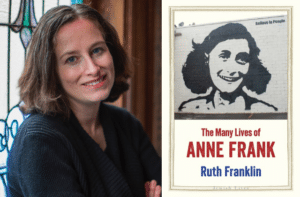The Complicated Legacy of Anne Frank
April 17, 2025 in Library Corner
By Robin Jacobson
 For millions around the globe, the face of Anne Frank – bright, sensitive, and all-too-young – is instantly recognizable. For many, she represents the six million Jews, including 1.5 million children, murdered in the Shoah. But for many others, she has become a generic symbol of innocent suffering, invoked for a dizzying array of causes.
For millions around the globe, the face of Anne Frank – bright, sensitive, and all-too-young – is instantly recognizable. For many, she represents the six million Jews, including 1.5 million children, murdered in the Shoah. But for many others, she has become a generic symbol of innocent suffering, invoked for a dizzying array of causes.
The Many Lives of Anne Frank by Ruth Franklin recognizes that Anne has become an icon, but emphasizes that she was first and foremost a real-life, talented teenager forced to hide and then murdered because she was Jewish. In this excellent and unusual biography, Franklin sets forth Anne’s life and times and then explores the cultural afterlife of her famous diary.
World War II in the Netherlands
The Frank family – Otto and Edith and their young daughters, Margot and Anne – were German Jews who moved to Amsterdam from Frankfurt soon after Hitler came to power in 1933. They sought (and initially found) in the Netherlands a safe haven from the Nazi regime. Even after World War II began in September 1939, there was reason to hope that the Netherlands would remain neutral territory as it was in World War I.
Those hopes were shattered on May 10, 1940, when Germany attacked the Netherlands, notwithstanding the Dutch policy of neutrality. Within five days, the Netherlands military surrendered, and Queen Wilhelmina and the government cabinet fled to London where they established a government-in-exile.
Persecution of Jews in the Netherlands began intensifying about six months later, with a rapid succession of anti-Jewish restrictions, prohibitions, and mandates. In July 1942, when deportations to concentration camps began, the Franks moved to the hidden apartment above Otto Frank’s Amsterdam business. Joined by four other German Jews, they remained successfully hidden for more than two years, thanks to the heroic support of Otto Frank’s colleagues and employees.
In March 1944, Anne began working on a revised version of her diary, intended for eventual publication. She was inspired by a radio address in which a Dutch minister of the government-in-exile called on ordinary citizens to retain their personal wartime documents for inclusion in a future national archive.
Tragically, a few months later, in August 1944, a still unknown person betrayed the hidden annex group. All were sent to concentration camps, and only Otto Frank survived. The seven others, along with an estimated 75% of Jews in the Netherlands, were murdered.
The Afterlife of Anne’s Diary
After the war, Otto Frank felt compelled to share Anne’s diary, hoping it would promote tolerance towards all peoples, while also “work[ing] against anti-Semitism.” After compiling and editing Anne’s diary versions into one manuscript, he arranged for the diary to be published in the Netherlands (1947) and the United States (1952). The diary was later adapted into a Broadway play and film.
Despite Otto’s hopes that the diary would carry both a universal and a particular message regarding prejudice, the marketing and portrayals of Anne’s story often tended to minimize her Jewish identity, even though that was the reason she was persecuted. Over time, she has become a generic icon of victimhood, used to promote all manner of causes, from the protection of undocumented immigrants to freedom from vaccine mandates. Anne’s image has even been incorporated into anti-Zionist messages that ignore the facts of her life.
Franklin appreciates that Anne Frank’s diary resonates beyond its Jewish context, but contends that her Jewish identity must not be erased. “To do Anne justice,” writes Franklin, “we must learn to see her as both a symbol of all persecution and a target of antisemitism – an icon and a human being.”
Read about Anne Frank in fiction at https://www.bethelmc.org/2012/06/haunted-by-anne-frank/